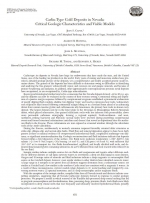Добрый день, Коллеги. Важное сообщение, просьба принять участие. Музей Ферсмана ищет помощь для реставрационных работ в помещении. Подробности по ссылке
Carlin-type gold deposits in Nevada: critical geologic characteristics and viable models
Carlin-type Au deposits in Nevada have huge Au endowments that have made the state, and the United States, one of the leading Au producers in the world. Forty years of mining and numerous studies have provided a detailed geologic picture of the deposits, yet a comprehensive and widely accepted genetic model remains elusive. The genesis of the deposits has been difficult to determine owing to difficulties in identifying and analyzing the fine-grained, volumetrically minor, and common ore and gangue minerals, and because of postore weathering and oxidation. In addition, other approximately contemporaneous precious metal deposits have overprinted, or are overprinted by, Carlin-type mineralization.
Recent geochronological studies have led to a consensus that the Nevada deposits formed ~42 to 36 m.y. ago, and the deposits can now be evaluated in the context of their tectonic setting. Continental rifting and deposition of a passive margin sequence followed by compressional orogenies established a premineral architecture of steeply dipping fluid conduits, shallow, low dipping “traps” and reactive calcareous host rocks. Sedimentary rock sequences that formed following continental margin rifting or in a foreland basin ahead of an advancing thrust front contain reactive pyritic and carbonaceous silty limestones, the primary host rocks in almost every deposit. The largest deposits now lie in the lower plate to the Devonian to Mississippian Roberts Mountain thrust, which placed nonreactive, fine-grained siliciclastic rocks with less inherent rock permeability, above more permeable carbonate stratigraphy, forming a regional aquitard. North-northwest– and west-northwest–striking basement and Paleozoic normal faults were inverted during postrifting compressional events and formed structural culminations (anticlines and domes) that served as depositional sites for auriferous fluids in the Eocene. These culminations are now exposed as erosional windows through the siliciclastic rocks of the Antler allochthon.
During the Eocene, northwesterly to westerly extension reopened favorably oriented older structures as strike-slip, oblique-slip, and normal-slips faults. Fluid flow and mineral deposition appear to have been fairly passive as there is minimal evidence for overpressured hydrothermal fluids, complicated multistage vein dila-tancy, or significant synmineralization slip. Geologic reconstructions and fluid inclusions indicate that deposits formed within a few kilometers of the surface. Ore fluids were moderate temperature (~180°–240°C), low salinity (~2–3 wt % NaCl equiv), CO2 bearing (<4 mol %), and CH4 poor (<0.4 mol %), with sufficient H2S (10–1–10–2 m) to transport Au. Ore fluids decarbonatized, argillized, and locally silicified wall rocks, and deposited disseminated pyrite containing submicron Au as Fe liberated from wall rock reacted with reduced S in the ore fluid.
Isotopic studies indicate multiple sources for ore fluids and components and require either different models for different districts or call upon meteoric waters to overwhelm a deep ore-fluid signal in most districts. Oxygen and H isotope ratios of minerals and fluid inclusions indicate a deep magmatic or metamorphic fluid source at the Getchell deposit; however, most similar studies in other districts have identified meteoric water. A large range in S isotopes in ore pyrite from all districts suggests derivation from a sedimentary source; yet studies at Getchell and a few studies in the northern Carlin trend are consistent with a magmatic S source. As a result of these inconsistencies, current models relate deposits to (1) metal leaching and transport by con-vecting meteoric water, (2) epizonal intrusions, and (3) deep metamorphic and/or magmatic fluids.
With the exception of the isotopic studies, compiled data from all Nevada trends and districts indicate compelling similarities, suggesting that all Nevada Carlin-type deposits formed in response to similar geologic processes. We propose a model in which removal of the Farallon slab promoted deep crustal melting that led to prograde metamorphism and devolatilization, thus generating deep, primitive fluids. Such fluids were likely incorporated in deep crustal melts that rose buoyantly and ultimately exsolved hydrothermal fluids, possibly containing Au. Metamorphism at midcrustal levels may have contributed fluids, all of which were collected into basement-penetrating rift faults, where they continued to rise and scavenge various components, evolving in composition to become ore fluids. North-northwest–trending paleo-normal faults and northeast-trending paleo-transform faults, preferentially dilated during Eocene extension, controlled the regional position, orientation, and alignment of the deposits. Eventually the ore fluids accumulated in areas of reduced mean effective stress, particularly boundaries of older Jurassic and Cretaceous stocks and structural culminations. The ore fluids were diluted by exchanged meteoric water as extension increased fault permeability in the upper crust. Within a few kilometers of the surface, fluids were diverted by structural and stratigraphic aquitards into reactive host rocks, where they sulfidized host rock iron and deposited Au.
Sedimentary rock-hosted disseminated Au deposits in other parts of the world exhibit many similarities to Nevada Carlin-type Au deposits, yet no district has been discovered anywhere else that approaches Nevada’s Au productivity. The deposits found in other parts of the world are products of diverse, well-recognized, hy-drothermal systems (e.g., low-sulfidation epithermal, porphyry Cu-Mo-Au, reduced intrusion-related epizonal orogenic, and sedimentary exhalative or sedex). Of these, the deposits in southern China are remarkably similar to Nevada Carlin-type deposits and are interpreted to have formed where metamorphic fluids reacted with wall rocks and local meteoric water.




